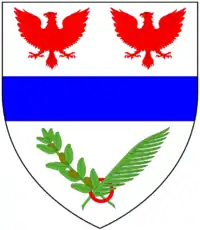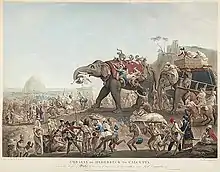Sir John Kennaway, 1st baronet (6 March 1758 – 1 January 1836), of Escot House in the parish of Talaton in Devon, was a British soldier and diplomat.
Life
After Kennaway left Exeter Grammar School in 1772, he became a cadet of the East India Company's forces, through the influence of Robert Palk, a relation on his mother's side.[2]
Kennaway served in the Carnatic, marching south with a brigade from the Presidency of Bengal in 1781, and taking part in the Second Anglo-Mysore War.[2] He served as British Resident at the Court of Nizam Ali Khan, Asaf Jah II, Nizam of Hyderabad. In September 1788 he implemented the agreed transfer of the Northern Circars from Hyderabad to the Presidency of Madras[3]
In recognition of his part in the negotiation of the 1790 alliance between the Nizam and the East India Company against Tipu Sultan,[4] Kennaway in 1791 he was created a baronet "of Hyderabad".[5] He concluded a treaty with Tipu Sultan in 1792.[6]
In 1794 Kennaway returned to England, and purchased Escot House, Ottery St Mary.[2]

Family
Kennaway married Charlotte Amyatt, daughter of James Amyatt; they had seven sons and five daughters.[8][6] Their son, Sir John Kennaway, who succeeded as 2nd Baronet, married Emily Frances Kingscote (b. 2 Aug 1805, d. 16 May 1858) on 28 April 1831. He was a noted evangelical Christian.[9]
The eldest daughters were Charlotte Eliza (1799–1875), who married George Templer, and Maria (1801–1876), who married Francis William Newman.[10][11][12] Frances married Edward Cronin in 1838;[13] and Susan married Gerard Thomas Noel, as his second wife.[14] The other daughter was Augusta.[15]
The second son, Charles Edward Kennaway (1800–1875) was a graduate of St John's College, Cambridge and a cleric. He married firstly Emma, daughter of Gerard Thomas Noel, and secondly Olivia, daughter of Lewis Way.[16] He and his elder brother John visited Robert Southey in their student days.[10] Two other sons, Laurence (died 1822) and William Richard, were in the Bengal Civil Service.[17]
References
- ↑ "print, Object: Embassy of Hyderbeck to Calcutta,British Museum". The British Museum.
- 1 2 3 Carnduff, Brendan. "Kennaway, Sir John, first baronet (1758–1836)". Oxford Dictionary of National Biography (online ed.). Oxford University Press. doi:10.1093/ref:odnb/15359. (Subscription or UK public library membership required.)
- ↑ Department, India Foreign and Political (1892). A Collection of Treaties, Engagements, and Sanads Relating to India and Neighbouring Countries. Office of the Superintendent of Government Printing, India. p. 299.
- ↑ Kidd, Charles, Debrett's peerage & Baronetage 2015 Edition, London, 2015, p.B455
- ↑ "No. 13281". The London Gazette. 12 February 1791. p. 87.
- 1 2 Lee, Sidney, ed. (1892). . Dictionary of National Biography. Vol. 30. London: Smith, Elder & Co.
- ↑ Kidd, Charles, Debrett's peerage & Baronetage 2015 Edition, London, 2015, p.B454
- ↑ Cave, Edward; Nichols, John (1836). "The Gentleman's Magazine". Google Search. p. 314. Retrieved 28 September 2017.
- ↑ The Christian observer [afterw.] The Christian observer and advocate. 1873. p. 558.
- 1 2 Matthews, Samantha (10 September 2020). Album Verses and Romantic Literary Culture: Poetry, Manuscript, Print, 1780-1850. Oxford University Press. p. 225. ISBN 978-0-19-885794-5.
- ↑ Debrett, John (1839). The Baronetage of England. J.G. & F. Rivington.
- ↑ Stunt, Timothy C. F. (23 September 2004). "Newman, Francis William (1805–1897), classical scholar and moral philosopher". Oxford Dictionary of National Biography (online ed.). Oxford University Press. doi:10.1093/ref:odnb/20019. (Subscription or UK public library membership required.)
- ↑ Akenson, Donald H. (14 August 2018). Exporting the Rapture: John Nelson Darby and the Victorian Conquest of North-American Evangelicalism. Oxford University Press. p. 124. ISBN 978-0-19-088272-3.
- ↑ Debrett's illustrated baronetage and knightage (and companionage) of the United Kingdom of Great Britain and Ireland. 1880. p. 253.
- ↑ Thom's Directory of Ireland. 1873. p. 400.
- ↑ "Kennaway, Charles Edward (KNWY817CE)". A Cambridge Alumni Database. University of Cambridge.
- ↑ A Genealogical and Heraldic Dictionary of the Peerage and Baronetage of the British Empire. Henry Colburn. 1839. p. 589.
